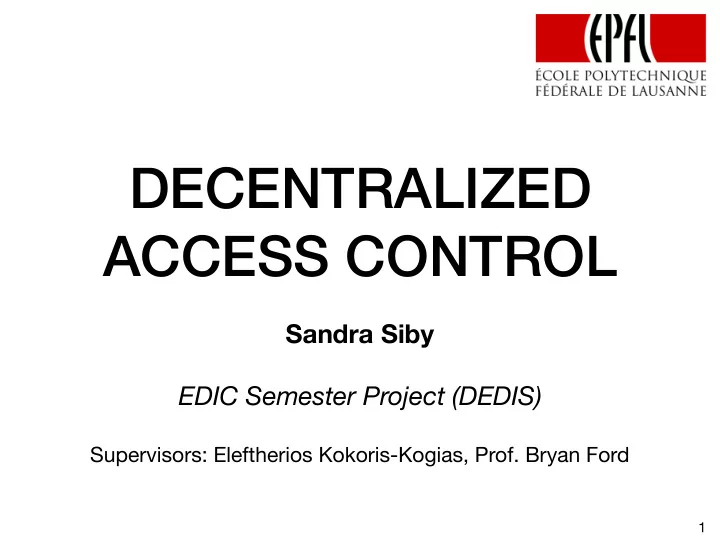

DECENTRALIZED ACCESS CONTROL Sandra Siby EDIC Semester Project (DEDIS) Supervisors: Eleftherios Kokoris-Kogias, Prof. Bryan Ford 1
Motivation • Access Control: Management of access to a resource • Simple access control • Static binding of a resource to a key • Key changes by owner? • Organization of users into groups? • Multiple rules or rules with conditions? • Changes to access control rule? 2
Project Aim • Design and implement a system that achieves the following: • Creation and management of access control rules • Allows users to manage their identities independent of the access control rules • Creation and management of groups of users for better organization • Evolution of identities and access control with time 3
Related Work • At DEDIS • Managing Identities Using Blockchains and CoSi [1] • CISC (Cisc Identity Skipchains) [2] • DARC (Distributed Access Rights Control) • Blockchain Based Access Control [3] 4
System Overview • Several types of access control: DAC, MAC, RBAC • ABAC - Attribute Based Access Control • Usage of Policies • JSON based access control language to express policies • Design • Policy Structure • Access Requests • Request Verification 5
Design Overview • Policy Structure • Access Requests • Request Verification 6
Policy • Consists of: • ID JSON based language • Version { "ID" : 6783, • List of Rules "Version" : 5, "Rules" : [Rule0, Rule1] } 7
Rule • Consists of: • Action (user specified) • Subjects JSON based language • Public Key { "Action" : "Read", • Another Policy ID "Subjects" : [GroupA_ID, Bob_PK], "Expression" : "{'AND' : [0, 1]}” } • Expression 8
Expressions • Allows for more sophisticated conditions • Basic format: {operator : [operand]} • Operations can be combined to build complex expressions • Examples: • “Need S1 and S2’s approval” -> S1 AND S2 -> {“AND” : [S1, S2]} • “Need either S1 and S2 or S3 and S4 to approve” -> (S1 AND S2) OR (S3 AND S4) -> {“OR” : [{“AND” : [S1, S2]}, {“AND” : [S3, S4]}]} • Current functionality: Logical operations AND/OR/NOT 9
Example • Access Control and Identity Management can be achieved using policies • Admins for policies 10
Design Overview • Policy Structure • Access Requests • Request Verification 11
Access Requests • Request consists of • Policy ID - target access policy • Rule Index - specific rule indicating access • Message - extra relevant information • Signing • Requester signs request with signing key • Request Signature consists of signed request and requester’s public key • Requester sends Request + Request Signature 12
Design Overview • Policy Structure • Access Requests • Request Verification 13
Verification • Verifier checks signature • Verifier checks path from access policy to requester 14
Verification - Multisig • Requester sends Request + List of signatures • Verifier checks all signatures • Verifier checks all paths • Verifier validates expression 15
Verification: Multiple paths? • Example: Request needs signature from member of EDIC • Mechanism to choose path required • On verifier or requester side 16
Path Selection by Requester • Signing • Requester searches for all paths • Picks appropriate path • Sends path information with request • Request Signature consists of signed request + public key + path • Verification • Verifier checks signature • Checks path in requester’s message • Checks presence of key in path 17
Evolving Policies • Skipchain architecture can be used (integration to be done) • Each policy object gets a skipchain • Allows for verified record of all policy changes over time • Skiplinks assist in fast traversal during path search 18
Evaluation • Unit tests to check implemented functionality • Benchmark tests for verification functions • Single signature request verification • Multi signature request verification • Single signature with path selection request signing and verification 19
Benchmark Results • Total verification time for single signature requests • Depth of requester is varied (depth = distance between target policy and requester’s parent policy) • Signature verification = ~381 us • Signature verification accounts for 92.04 - 99.94 % of total Total verification time = verification time Signature verification time + Path finding time 20
Benchmark Results • Verification rate for multi-signature requests • Number of signatures in request is varied • Requester depth is set to 2 and 10 21
Benchmark Results • Signing and verification for multi-path • Signing rate ~530 at 500 paths, depth 2 • Verification time is dominated by signature verification • Verification time similar to single signature verification case 22
Conclusion • Achieved • Design, implementation and testing of a policy based access control system • Functionality: Policy Creations, Access Requests and Verification • API in Google Doc [4], Code on Github [5] • Future Work • THR operator + weights in expressions • {“THR” : [thr_val, Subject1, weight1, Subject2, weight2…]} • Extensions of attributes in the access control model • Sub-policies and policy linking • Integration with skipchain architecture • Alternatives to the ‘one policy per skipchain’ model 23
References • [1] Kokoris-Kogias, L., Gasser, L., Kho ffi , I., Jovanovic, P ., Gailly, N. and Ford, B., 2016. Managing Identities Using Blockchains and CoSi . In 9th Workshop on Hot Topics in Privacy Enhancing Technologies (HotPETs 2016) • [2] CISC Identity SkipChain : https://github.com/dedis/cothority/tree/ master/cisc • [3] Maesa, D.D.F . and Ricci, L., 2017, June. Blockchain Based ., Mori, P Access Control . In IFIP International Conference on Distributed Applications and Interoperable Systems (pp. 206-220). Springer, Cham. • [4] API description : https://docs.google.com/document/d/ 1OoH0ecg1EF4xybD1tQAx9Ei7klHj-rYFYk1aRFoSFg0/edit?usp=sharing • [5] Implementation code : https://github.com/sandrasiby/ cothority_template - creating_policies branch 24
Recommend
More recommend